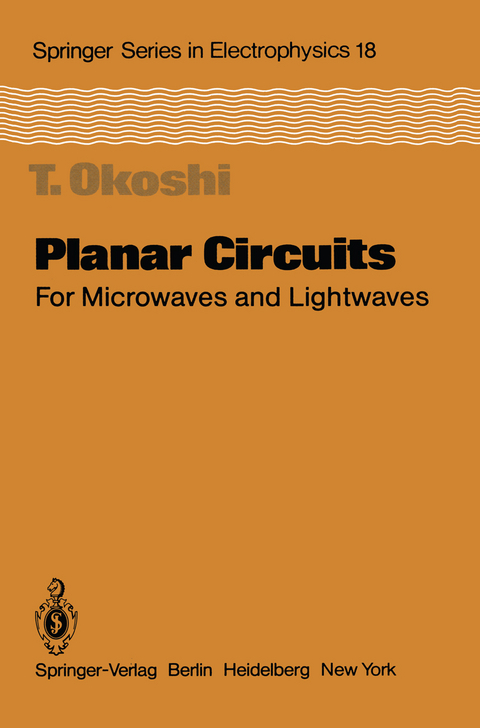
Planar Circuits for Microwaves and Lightwaves
Springer Berlin (Verlag)
978-3-642-70085-9 (ISBN)
1. Introduction.- 1.1 Seven Ranks in Electrical and Optical Circuitry.- 1.2 Classification and Technical Significance of Planar Circuits.- 1.3 History of Planar Circuit Research.- 1.4 History of Optical Planar Circuit Research.- 1.5 Purpose and Organization of This Book.- 2. Analysis of Planar Circuits Having Simple Shapes.- 2.1 Background.- 2.2 Basic Equations.- 2.3 Derivation of Circuit Characteristics.- 2.4 Examples of Analysis Based on Green's Function.- 2.5 Determination of Equivalent Circuit Parameters Based on Energy Consideration.- 2.6 Equivalent Circuit of a Multiport Planar Circuit.- 2.7 Validity of the Open-Boundary Assumption.- 2.8 Examples of Planar Circuits Having Simple Shapes.- 2.9 Summary.- 3. Analysis of Planar Circuits Having Arbitrary Shapes.- 3.1 Background.- 3.2 Basic Formulation of the Contour-Integral Method.- 3.3 Circuit Parameters of an Equivalents N Port.- 3.4 Transfer Parameters of a Two-Port Circuit.- 3.5 Numerical Computation Procedure.- 3.6 Examples of Computer Analysis by the Contour-Integral Method.- 3.7 Analyses Based on Eigenfunction Expansion.- 3.8 Summary.- 4. Short-Boundary Planar Circuits.- 4.1 Background.- 4.2 Principle of Analysis.- 4.3 Short-Boundary Planar Circuit Having Two Coaxial Coupling Ports.- 4.4 Short-Boundary Planar Circuit Having Two Waveguide Coupling Ports.- 4.5 Examples of Numerical Analysis.- 4.6 Higher-Order Mode Consideration at Reference Planes.- 4.7 Summary.- 5. Segmentation Method.- 5.1 Background.- 5.2 Theory of Segmentation Method Using S Matrices.- 5.3 Theory of Segmentation Method Using Z Matrices.- 5.4 Summary.- 6. Trial-and-Error Synthesis of Optimum Planar Circuit Pattern.- 6.1 Background.- 6.2 Method of Synthesis.- 6.3 Comparison with Experiment.- 6.4 Computer Time.- 6.5 Summary.- 7. FullyComputer-Oriented Synthesis of Optimum Planar Circuit Pattern.- 7.1 Background.- 7.2 Method of Synthesis.- 7.3 Parameters and Computational Techniques in an Actual Example of Synthesis.- 7.4 Results of Synthesis.- 7.5 Experimental Verification.- 7.6 Further Improvement of Frequency Characteristics by Addition of External Circuits.- 7.7 Evaluation of the Synthesized Circuit Patterns.- 7.8 Summary.- 8. Planar Circuits with Anisotropic Spacing Media.- 8.1 Background.- 8.2 Theories of Analysis.- 8.3 Formulations for Numerical Computation and Examples of Calculation.- 8.4 Comparison of the Eigenfunction-Expansion and Contour-Integral Methods.- 8.5 Optimum Design of Ferrite Planar Circuits.- 8.6 Summary.- 9. Optical Planar Circuits.- 9.1 Background.- 9.2 Wave-Optics Approach to Optical Planar Circuits.- 9.3 Geometrical Optics Approach to Optical Planar Circuits.- 9.4 Optical Planar Circuits Having Uniform Slab Structure.- 9.5 Optical Planar Circuits Having Periodic Structures.- 9.6 Planar Lenses.- 9.7 Summary.- 10. Optical Planar Circuits Having Stripelike Waveguiding Structures.- 10.1 Background.- 10.2 Model to be Considered.- 10.3 Geometrical Optics Approach.- 10.4 Wave-Optics Approaches.- 10.5 Beam-Propagation Method.- 10.6 Summary.- A2.1 Derivation of (2.5).- A2.2 Some Characteristics of Eigenvalues and Eigenfunctions.- A3.1 Weber's Solution Using Cylindrical Waves.- A3.2 Derivation of (3.1).- A3.3 Choice of the Green's Function Used in Contour-Integral Analysis.- A4.1 Proof of (4.1) for a Multiply Connected Circuit Pattern.- A8.1 Derivation of (8.5, 8).- A8.2 Derivation of (8.18, 19).- A9.1 Derivation of (9.27).- A9.2 Derivation of (9.32, 33).- References.
| Erscheint lt. Verlag | 17.11.2011 |
|---|---|
| Reihe/Serie | Springer Series in Electronics and Photonics |
| Zusatzinfo | XVI, 202 p. |
| Verlagsort | Berlin |
| Sprache | englisch |
| Maße | 155 x 235 mm |
| Gewicht | 346 g |
| Themenwelt | Naturwissenschaften ► Physik / Astronomie ► Optik |
| Technik ► Elektrotechnik / Energietechnik | |
| Schlagworte | Circuit • Design • microwave • Planar |
| ISBN-10 | 3-642-70085-3 / 3642700853 |
| ISBN-13 | 978-3-642-70085-9 / 9783642700859 |
| Zustand | Neuware |
| Haben Sie eine Frage zum Produkt? |
aus dem Bereich


